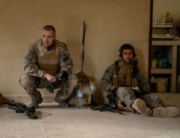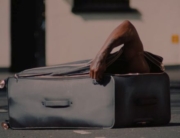![]() With Hugo and The Artist reminding audiences of the impact, and neglect, of silent films, comes the timely work of an avant-garde artist who imaginatively re-purposes archival footage in collaborations with contemporary musicians. Through six thematic movements, The Miners’ Hymns (now at Film Forum) opened the retrospective “Bill Morrison: A Modern Master of Silent Film” at the recent Silent Films/Live Music series with a live performance of Johann Johannsson’s stirring score, achingly performed by the Wordless Music Orchestra. This presentation made clearer how the silent footage is integrated with the music than in my first viewing at last year’s Tribeca Film Festival.
With Hugo and The Artist reminding audiences of the impact, and neglect, of silent films, comes the timely work of an avant-garde artist who imaginatively re-purposes archival footage in collaborations with contemporary musicians. Through six thematic movements, The Miners’ Hymns (now at Film Forum) opened the retrospective “Bill Morrison: A Modern Master of Silent Film” at the recent Silent Films/Live Music series with a live performance of Johann Johannsson’s stirring score, achingly performed by the Wordless Music Orchestra. This presentation made clearer how the silent footage is integrated with the music than in my first viewing at last year’s Tribeca Film Festival.
Foghorns seem to blare in the distance during the opening aerial approach over the northeast England coast, heading through the mists of time in the 10-minute opening movement “They Being Dead yet Speaketh.” (For a Morrison film, these contemporary color segments by Steve Desbrow are atypical). Flying over empty fields, parking lots, and shopping malls, names and dates appear, as if from old maps, of the mining sites (called collieries) that had operated for more than one hundred years, one from 1855 to 1968, another from 1809 to 1929.
In the elegiac second movement, “An Injury to One is the Concern of All,” people from the past appear in black and white, morphing in dress styles over those decades, but all silently waiting for news of survivors from one mining disaster after another. (The film’s title and Johannsson’s leitmotifs are taken from a memorial hymn for miners killed in 1934.) Glimpsed in these anxious crowds are the colliery brass bands, and the score incorporates brass brand instrumentation. (The ending of that long tradition was marked in the 1996 feature Brassed Off.)
In the 11-minute “Freedom From Want and Fear,” Morrison edits footage from the National Coal Board’s Film Unit, preserved by the British Film Institute National Archive (also in a nod to its 75th Anniversary), to show the rhythms of the miners’ daily grind—the pre-dawn walk to work from the company houses; the mass of laborers heading down to dig, first with horses, then underground trains; and the encroaching mechanization on an ever larger scale. Johannsson’s score sensitively resists the bombastic accompaniment of so many documentaries that use silent film;
“There is No Safe Side but the Side of Truth” expands on the themes of environmental and human degradation caused by the industry over the century. The endless rows of miners’ housing are caught in sooty smog, the coast is clogged with coal slurry, and children turn mountains of coal slag into playground slides. And then there’s the beginning of the end. As Morrison shifts from archival footage to television coverage, the community and the police brace for the strikes of the 1980s.
The “Industrial and Provident, We United to Assist Each Other” movement is a sobering counterpart to the sympathetic portrayal of Prime Minister Margaret Thatcher’s industrial policies in the current The Iron Lady as bobbies beat miners protesting over the shutdown of their livelihoods. The helicopter tour of the scenes of closed collieries resumes—one is now an artificial snow slide, another an empty stadium.
Like ghosts, the proud miners and their families return in the stately final movement, “The Cause of Labor Is the Hope of the World,” a montage from years of the Durham Miners’ Gala. Since 1871, the “Big Meeting” was the largest annual trade union gathering in Europe, where each lodge paraded with its own band and militant banners, a heritage that is the basis for the BRASS – Durham International Festival, which commissioned this piece.
Also in the series, Morrison’s The Great Flood is a more historical and chronological approach to a human disaster, edited for political and social points, with folksy music by guitarist Bill Frisell. He had lots of newsreel footage to draw from of the record rain, raging waters, and tall heights of mud that inundated hundreds of thousands of acres and overwhelmed people all along the Mississippi River and its tributaries in 1927, which, unfortunately, still seems familiar. (An episode of PBS’s American Experience “Fatal Flood” a decade ago covered this influential event very well.) The pre- and post-flood footage of the lives of African Americans is extraordinary, and justifies screening this film in educational settings.
Morrison’s recent historical approach to rediscovering archival and “found footage” is a contrast to his first major, hour-long work, Decasia (2002), that concluded this year’s series, accompanied with an exquisite live performance of Michael Gordon’s throbbing score by the Oberlin Contemporary Music Ensemble. He used decaying celluloid, particularly of nitrate film (that Scorsese in Hugo laments led to the loss of Georges Méliès’ oeuvre) to strikingly symbolize despair for the future of mankind. The damaged blotches and distortions of individual frames look like human devolution, going from microorganisms to monsters. So many times I’ve found the “found footage” movement in documentary filmmaking just an excuse for lazy or gimmicky editing, but Morrison’s creative teaming with musicians, combined with empathy and a strong sensibility for the raw material, raises appreciation for archival silent footage to another level.
Film Forum will also be screening three Morrison shorts: Release (2010), a pan of an expectant crowd waiting, to no avail, to see Al Capone leave jail in 1930; Outerborough (2005), an 1899 crossing of the Brooklyn Bridge; and The Film of Her (1996), a history of the movies through a compilation of classic movie clips from the Library of Congress.
















Leave A Comment